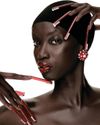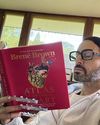
At a glance, the west side of Fifth Avenue between 125th and 126th streets teems with information about what Harlem is, what it was, and what it ’s still becoming. There are the area’s mainstays—an African hair-braiding place, an all-important corner store—with a big Baptist church just north, between 126th and 127th. There’s a sense of history by proximity—the Apollo Theater is a few blocks west, Maya Angelou’s old town house sits a few blocks south— but the markers of “modern” Harlem are apparent too. On 125th and Fifth, what was once a large, rather dark Applebee’s is now a slightly hipper Shake Shack, and for years Neil Patrick Harris and David Burtka lived with their twins in the late-19thcentury brownstone three doors up.
Towering over all of this to the east—and, in a way, helping to tie it all together—is Ray Harlem, opening this December. The 21-story pink brick building, designed by Frida Escobedo in partnership with Handel Architects, houses more than 200 apartments (ranging from studios to two-bedrooms), with all the modern amenities and conveniences you’d expect. It is also home to something quite singular: the National Black Theatre (NBT), an institution first established in Harlem in 1968. Due to stage its first performances in late 2027, the theater, designed by Marvel Architects, will command some 25,000 square feet of the complex and feature both a 250-seat flexible space—imagine the Park Avenue Armory’s Drill Hall in miniature—and a 99-seat studio theater. Studio & Projects, a firm run by Brooklyn-based designer Little Wing Lee, is overseeing the interiors throughout with Escobedo’s studio and Ray’s in-house team. The vision, Lee says, is “a lot of texture” and “a lot of really beautiful colors and materials,” including custom stained glass for the residents entrance.
This story is from the November 2024 edition of Vogue US.
Start your 7-day Magzter GOLD free trial to access thousands of curated premium stories, and 9,000+ magazines and newspapers.
Already a subscriber ? Sign In
This story is from the November 2024 edition of Vogue US.
Start your 7-day Magzter GOLD free trial to access thousands of curated premium stories, and 9,000+ magazines and newspapers.
Already a subscriber? Sign In

FINAL CUT
\"WE WANT YOU TO GO FOR IT!\" ANNA TOLD ME

SCREEN TIME
Three films we can't wait to see.

Impossible Beauty
Sometimes, more is more: Surreal lashes and extreme nails put the fierce back in play

Blossoms Dearie
Dynamic, whimsical florals and the humble backdrops of upstate New York make for a charming study in contrasts.

HOME
Six years ago, Marc Jacobs got a call about a house designed by Frank Lloyd Wright. Making it his own, he writes, would be about love, commitment, anxiety, patience, struggle, and, finally, a kind of hard-fought, hard-won peace.

GIRL, INTERRUPTED
Anna Weyant found extraordinary fame as an artist before she had reached her mid-20s. Then came another kind of attention. Dodie Kazanjian meets the painter at the start of a fresh chapter

ROLE PLAY
Kaia Gerber is someone who likes to listen, learn, read books, go to the theater, ask questions, have difficult conversations, act, perform, transform, and stretch herself in everything she does. That she's an object of beauty is almost beside the point.

CALLAS SHEET
Maria Callas's singular voice made her a legend on the stage. In a new film starring Angelina Jolieand on the runwaysthe romance continues.

BOOK IT
A preview of the best fiction coming

GLOBAL VISTAS
Three new exhibitions offer an expansive view.